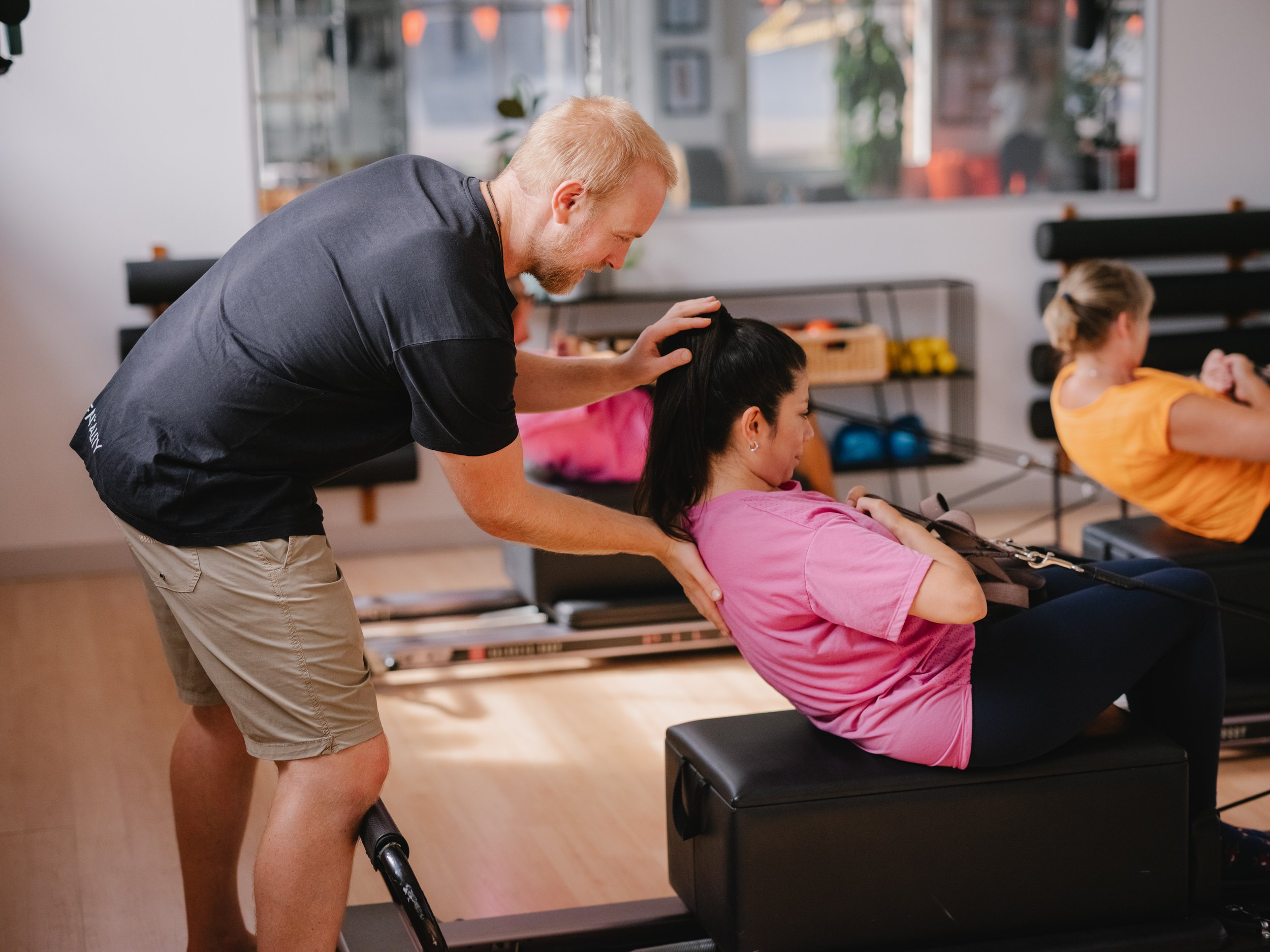Movement and Touch - from the perspective of a Somatic Movement Therapist
Movement and Touch are two vital components of the work we do at Movementality and are deeply intertwined when it comes to healing. They also happen to be two fundamental components of what it means to be human.
Whether it be a physical training modality such as Pilates or more treatment-based modalities such as Myotherapy, Functional Neurology or Somatic Movement Therapy, touch plays an important role in initiating, enhancing and supporting movement. Throughout this blog I aim to highlight how movement and touch intersect in the Movementality studio and how I use them as a Somatic Movement Therapist to facilitate the greatest learning and embodiment experiences for my clients.
Providing a hands on experience for a client to experience more length on the Pilates Cadillac
In the beginning…
We first experience touch as early as the 6th week of utero where we begin to touch the sides of our mother’s womb. Then, at birth, we are placed on our mother’s chest (primary caregiver) for immediate “skin to skin” contact because science understands that early touch influences an infant’s biochemistry, neurological development and developmental movement patterning.
Our skin cells develop from our ectoderm in utero. This is the same place from where our primitive nervous system develops. This means that from the very beginning there is a commonality between our skin (how we experience external touch) and our nervous system - our inner and outer touch. Trauma research has discovered that when we experience a trauma, it leaves a ‘mark’ on our nervous system. Intentional therapeutic touch and skin contact has the capacity to affect the sensations we experience, thus impacting our nervous system and potentially speeding up the healing process.
The benefits of touch…
Touch is a form of communication and connection. Sometimes hands on support, like a hug or a rub on the back from a friend, can be more powerful than words. Touch evokes sensation and when we can feel, we are more likely to move. For example; when someone touches our shoulders as if to give us a massage, our sensory nerves feel that touch and send messages to our brain which in turn tell our muscles to move and respond. This is called our sensory motor feedback loop. In a therapeutic sense it can be used to educate someone about their body and how it works.
However, touch is so much more than a purely physical experience. Touch is sensory and physiological, and our physiology is interlinked with our emotions. Therefore touch can help inform personal boundaries, assist with self-identity and provide security. Self touch can promote self love or self acceptance and it can be another useful tool for reconnecting someone with their physical body.
How touch is used at Movementality
In Pilates and Somatic Movement Therapy (SMT) the use of touch as a tool can offer the client body autonomy and an experience of ‘choice’. For example, I may use ‘touch’ to evoke a sensation and/or movement option for the client to experience and from there I invite them to reflect on any changes or contrasts they feel in their body. By inviting the client to own this process, they become autonomous over their own body. They are relying on first person feedback from their own sensory motor loop, rather than waiting for an external person to give them answers about their own body! Through this process, and when they experience change or contrast, I am able to highlight to them the possibility that they have choices, specifically in the exercise I’ve given them, but also, and maybe more importantly, in their own life. In therapy, it is not enough to simply tell someone what they need to do, the profoundness comes when the client is able to make that discovery for themselves. In SMT, my goal is to facilitate this kind of discovery. Using touch and movement as tools provides us with ways to have the client somatically experience the choices they make and through this realise that there is power within themselves to make different choices and affect change in other aspects of their lives.
A therapist who does not use movement or touch may spend years hashing through details of someone’s past experiences and interactions to grasp what is below the surface of their problems. This is known as ‘getting stuck in the story.’ Even then, the client makes a choice of what to disclose in talk therapy and may not even remember some of the memories, if they have been suppressed. In SMT, the intention is to work directly with the body to help bring what is unconscious to the surface, so that it can be named by the conscious brain (either by the client or the therapist) and then understood and worked through. Every ‘body’ has an innate intelligence because it has lived through each experience. It may hold answers that the conscious brain does not. SMT can assist in bringing those answers forward because it taps into the sensations and the physiology of that person. The body does not lie and it cannot hide.
Written by Ashleigh Berry
Reference List
Applying Tactile Therapy in Somatic Movement Therapy. Tensegrity Training. T. Nicholson. 2019
Touch and Chronic Pain Resource Article. Tensegrity Training. T. Nicholson. 2019
A Quick and Simple Way To Think About The Brain. NICABM. 2017
Perceiving in Action. B. Bainbridge Cohen. 1984.
The Body Keeps The Score. B. Van Der Kolk. 2015
“affective feelings and tactile-kinesthetic feelings are experientially intertwined.” (Sheets-Johnstone 1999, p264).



